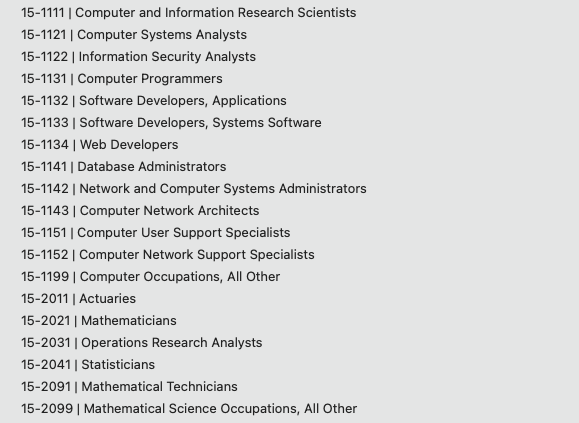
Eligibility criteria must be met in order to apply for an HCOP. Eligibility is defined as having a 2.5 GPA, being economically disadvantaged, or experiencing educational hardship. The program focuses on three key milestones in education: preparation for college, stress management, and health disparities. This article describes the steps needed to apply to HCOP. HCOP offers many benefits. This program is designed to provide the support and resources you need to succeed.
HCOP is a program that enables pipelines to be built.
The federally-funded grant program, Health Careers Opportunity Program, (HCOP), allows students from underrepresented backgrounds to attend and graduate from schools in the health professions. By participating in this program, students with low academic abilities can improve their skills as well as overcome academic barriers that could prevent them from entering the field. HCOP provides educational pathways for health careers and helps underrepresented students to graduate college. This program supports first-generation college students.
The program has become a model for healthcare training for low-income adults. HCOP helps to place more than 100 new jobs every year. HCOP is supported and promoted by the Association of American Medical Colleges and U.S. Department of Health and Human Services. The program encourages participants to make long-term career plans and pursue education that will lead to a fulfilling career. Hostos LPN certificate, Registered degree, and allied career associate degree programs will provide academic and career guidance for graduates.
It focuses on three important milestones in education
HCOP offers students from underrepresented backgrounds a path to a career within the health professions. It involves three educational milestones: high school graduation and acceptance into a college-level program in health professions. The Comprehensive Approach Funding Preference for the Comprehensive Approach has statutory power. It emphasizes the partnership between public-private entities to create a strong applicant pool.

Students who earn a less than 2.5 GPA during their first year will be required to complete a probationary phase. This program also includes a research component in order to evaluate its effectiveness. HCOP Ambassadors will require students to participate in research. Participation can be withdrawn at any time.
It helps participants prepare for college
Participants in the Health Careers Opportunity Program can prepare for college with an associate of arts (AAA) in liberal arts curriculum that focuses on mathematics and foundation sciences. Additional science courses prepare students for health-care careers. As the academic advisor, a program coordinator provides three hours of structured academic assistance each week during study sessions. Academic support is offered to students in order to improve their SAT scores, and academic performance.
There are two virtual summer experiences offered by the program, Health Science Summer Camp, and Health Science Summer Bridge Program. Both help participants prepare for college. The Bridge Program, which focuses on health-career-oriented skills, helps students build foundational skills. Non-credit instructors, recruited by the Health Careers Opportunity Program, assist students with the learning process, help them navigate obstacles and provide real-world experience to apply classroom content.
It increases retention
The Health Careers Opportunity Program, also known as HCOP, provides grants to accredited health professions schools, non-profit organizations that provide education and training, and disadvantaged individuals who wish to pursue a career in health care. This program funds projects that provide opportunities for people who are underserved in the health care professions. Its objective is to increase retention rates and matriculation for students studying health professions.

HCOP is an $15 million national pipeline program that supports students from disadvantaged backgrounds into the health care industry. The program helps students reach the three milestones of high school, college, and professional school. HCOP participants are much more likely to go on to college and find work in the field of health care than students who come from other ethnicities. The HCOP program increases retention rates for students in health care-related fields such as nursing, physician aids, and pharmacy.
FAQ
How can I control my blood pressure?
First, you must determine what is causing high blood pressure. Next, take steps that will reduce the risk. You can do this by eating less salt, losing weight, or taking medication.
Also, make sure to get enough exercise. If you don't have time for regular exercise, then try walking as often as possible.
A gym membership is a good idea if you don't like how much exercise your doing. You will likely want to join an exercise group that shares your goals. It's much easier to follow a routine if someone is with you at the gym.
How do I get enough vitamins for my body?
Your diet can provide most of your daily requirements. Supplements are available if you are deficient. Multivitamin supplements can be taken that contain all the vitamins you need. Or you can buy individual vitamins from your local drugstore.
Talk to your doctor if there are any concerns about getting enough nutrients. Dark green leafy vegetables like spinach, broccoli and kale, as well as turnip greens and mustard greens such as turnip and mustard greens and bok choy, are rich in vitamins K & E.
Ask your doctor to help you determine the right amount of vitamin. Based on your medical history and your current health, your doctor can recommend the correct dosage.
How often should I exercise
A healthy lifestyle requires regular exercise. There is no set time limit for exercising. The key is finding something you enjoy and stick with it.
You should aim to do 20-30 minutes of moderate intensity exercise three times per week. Moderate intensity means that your muscles will continue to work hard even after you finish. This type works out burns around 300 calories.
Walk for at least 10 minutes four days a weeks if you prefer walking. Walking is low in impact and easy for your joints.
Jogging for 15 minutes three days a week is a good option if you prefer to run. Running is a great way to burn off excess calories and build muscle tone.
Begin slowly if your are not used to working out. Start by doing 5 minutes of cardio each day, a few times per week. Gradually increase your cardio time until you reach the goal.
How does an anti-biotic work?
Antibiotics can be used to kill bacteria. Antibiotics are used to treat bacterial infections. There are many types and brands of antibiotics. Some are given orally, while some are injected. Other antibiotics are applied topically.
People who have been exposed are often given antibiotics. One example is if someone has had chickenpox and wants to prevent shingles. For those with strep-thorphritis, an injection of penicillin could be administered to prevent them from getting pneumonia.
If antibiotics are to be administered to children, they must be prescribed by a doctor. Children are more likely to experience side effects than adults from antibiotics.
Diarrhea being the most common side effect of antibiotics. Other side effects possible include dizziness, nausea, vomiting, stomach cramps, dizziness and allergic reactions. These symptoms usually go away after treatment ends.
These are 5 ways you can live a healthy and happy life.
Healthy living means eating right, exercising regularly and getting enough sleep. It also involves managing stress and having fun. Good eating habits include avoiding processed foods, sugar, unhealthy fats, and avoiding junk food. Exercise strengthens your muscles and helps you lose calories. You can improve your memory and concentration by getting enough sleep. Stress management reduces anxiety, depression and other symptoms. Fun is key to staying young and vibrant.
What's the problem with BMI?
BMI stands For Body Mass Index. This refers to the measurement of body fat using height and weight. BMI is calculated using the following formula:
Weight in kilograms divided by height in meters squared.
The result is expressed using a number from 0 through 25. A score of 18.5 or higher indicates overweight, while a score of 23 or higher indicates obesity.
A person who weighs 100 kilograms and is 1.75m tall will have an BMI of 22.
Statistics
- In both adults and children, the intake of free sugars should be reduced to less than 10% of total energy intake. (who.int)
- Extra virgin olive oil may benefit heart health, as people who consume it have a lower risk for dying from heart attacks and strokes according to some evidence (57Trusted Source (healthline.com)
- According to the 2020 Dietary Guidelines for Americans, a balanced diet high in fruits and vegetables, lean protein, low-fat dairy and whole grains is needed for optimal energy. (mayoclinichealthsystem.org)
- The Dietary Guidelines for Americans recommend keeping added sugar intake below 10% of your daily calorie intake, while the World Health Organization recommends slashing added sugars to 5% or less of your daily calories for optimal health (59Trusted (healthline.com)
External Links
How To
What does the meaning of "vitamin?"
Vitamins can be described as organic compounds found in food. Vitamins are necessary for us to absorb nutrients in the foods we consume. Vitamins cannot be made by the body; they must be taken from food.
There are two types if vitamins: water soluble, and fat soluble. Water-soluble vitamins dissolve readily in water. Examples include vitamin C,B1 (thiamine), B2 (riboflavin), B3 (niacin), B6 (pyridoxine), folic acid, biotin, pantothenic acid, and choline. Fat-soluble vitamins are stored in the liver, fatty tissue and kidneys. These include vitamin D, E and K, as well as beta carotene.
Vitamins are classified according to their biological activity. There are eight main groups of vitamins.
-
A - Essential for healthy growth and health maintenance.
-
C - vital for proper nerve function, and energy production.
-
D - necessary for healthy bones and teeth.
-
E is needed for good reproduction and vision.
-
K - Essential for healthy muscles and nerves.
-
P - vital for building strong bones andteeth.
-
Q - Aids in digestion and absorption.
-
R - necessary for making red blood cells.
The recommended daily allowance (RDA), for vitamins, varies depending upon age, gender, or physical condition. The U.S. Food and Drug Administration has established the RDA values.
For example, the RDA for vitamin A is 400 micrograms per dayfor adults 19 years or older. For fetal development, pregnant women need 600 mg per day. Children ages 1-8 require 900 micrograms per day. Infants below one year old require 700mg per day. But, between 9 months to 12 months, the amount drops to 500mg per day.
Children between the ages 1--18 years old who are overweight or obese require 800 micrograms per Day, while those who are overweight or obese need 1000 micrograms. To meet their nutritional needs, children underweight and obese require 1200 micrograms a day.
Children between 4 and 8 years old with anemia will need 2200 micrograms daily of vitamin C.
Adults over 50 years of age need 2000 micrograms per day for general health. Breastfeeding or pregnant women require 3000 micrograms per daily due to higher nutrient demands.
1500 micrograms is the recommended daily intake for adults aged 70+, who lose approximately 10% of muscle each year.
Women who are pregnant and lactating need more nutrients than the RDA. Pregnant women need 4000 micrograms per dayduring pregnancy and 2500 micrograms per day after delivery. Breastfeeding moms need 5000 micrograms each day when breastmilk production occurs.